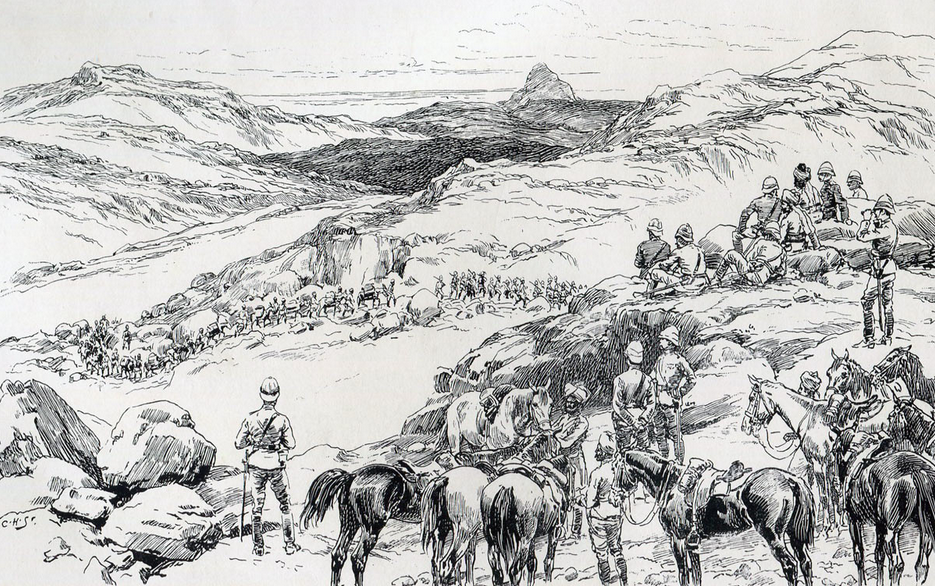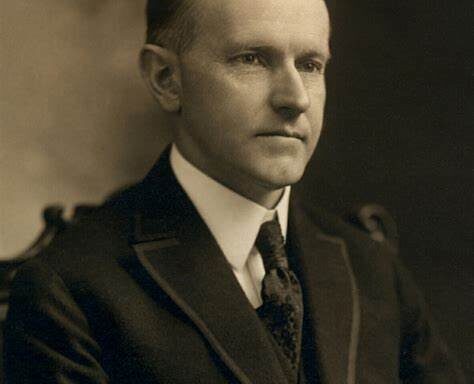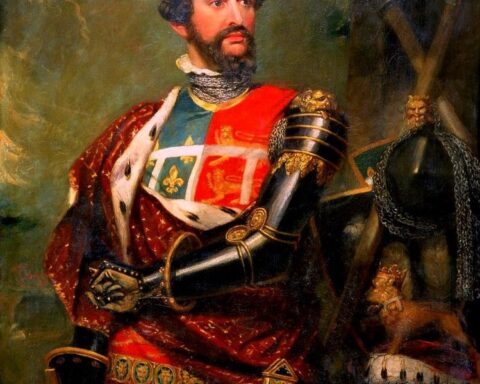Editor’s note: Here follows the eighth chapter of The Story of the Malakand Field Force: An Episode of Frontier War, by Winston S. Churchill (published 1898). All spelling in the original.
CHAPTER VIII: THE ADVANCE AGAINST THE MOHMANDS
The beginning of this chapter must mark a change in the standpoint from which the story is told. Hitherto the course of events has been recorded in the impersonal style of history. But henceforward I am able to rely on my own memory as well as on other people’s evidence. [I do not desire to bore the reader or depreciate the story by the introduction of personal matters. It will be sufficient if, in the interests of coherency, I explain my connection with the Malakand Field Force. Having realised, that if a British cavalry officer waits till he is ordered on active service, he is likely to wait a considerable time, I obtained six weeks’ leave of absence from my regiment, and on the 2nd of September arrived at Malakand as press correspondent of the PIONEER and DAILY TELEGRAPH, and in the hope of being sooner or later attached to the force in a military capacity.] It may be doubtful whether an historical record gains or loses value when described by an eye-witness. From the personal point of view, all things appear in a gradual perspective, according to the degree in which they affect the individual; and we are so prone to exaggerate the relative importance of incidents, which we see, over those we hear about, that what the narrative gains in accuracy of detail, it may lose in justness of proportion. In so nice a question I shall not pronounce. I remember that the original object with which this book was undertaken, was to present a picture of the war on the North-West Frontier to the Englishmen at home; a picture which should not only exist, but be looked at; and I am inclined to think, that this end will be more easily attained by the adoption of a style of personal narrative. Many facts, too local, too specialised, too insignificant, for an historical record, and yet which may help the reader to form a true impression of the scene and situation, are thus brought within the compass of these pages. The account becomes more graphic if less imposing, more vivid if less judicial. As long as each step down from the “dignity of history” is accompanied by a corresponding increase in interest, we may pursue without compunction that pleasant, if descending, path.
The ninth chapter also introduces a new phase of the operations of the force. The Mohmands now become the enemy and the scene is changed from Swat to Bajaur. Before marching into their country, it will be desirable to consider briefly those causes and events which induced the Government of India to despatch an expedition against this powerful and warlike tribe.
The tidal wave of fanaticism, which had swept the frontier, had influenced the Mohmands, as all other border peoples. Their situation was, however, in several important respects, different from that of the natives of the Swat Valley. These Mohmands had neither been irritated nor interfered with in any way. No military road ran through their territory. No fortified posts stirred their animosity or threatened their independence. Had they respected in others the isolation which they themselves have so long enjoyed, they might have remained for an indefinite period in that state of degraded barbarism which seems to appeal so strongly to certain people in England. They became, however, the aggressors.
In the heart of the wild and dismal mountain region, in which these fierce tribesmen dwell, are the temple and village of Jarobi: the one a consecrated hovel, the other a fortified slum. This obscure and undisturbed retreat was the residence of a priest of great age and of peculiar holiness, known to fame as the Hadda Mullah. His name is Najb-ud-din, but as respect has prevented it being mentioned by the tribesmen for nearly fifty years, it is only preserved in infidel memories and records. The Government of India have, however, had this man’s personality brought vividly before them on several occasions. About thirteen years ago he quarrelled with the Amir and raised the Mohmands against him. The Amir replied by summoning his rebellious subject—for Hadda, the Mullah’s home and birthplace, is a village of Afghanistan—to answer for his conduct at Cabul. But the crafty priest, who was well acquainted with Afghan legal procedure, declined the invitation, and retired to the independent Mohmand territory, where he has lived ever since.
Content with thus inflicting the punishment of exile, the Amir was disposed to forget the offence. In a letter to his Commander-in-Chief, the “Sipah Salar,” a great friend of the Mullah, he described him as a “light of Islam.” So powerful a light, indeed, he did not desire to have in his own dominions; but across the border it was fitting that respect should be shown to so holy a man. He therefore directed his officials to cherish and honour him. Thus he retained a powerful weapon—to be used when desirable. Whether by instigation or from personal motives, the Hadda Mullah has long been a bitter foe to the British power. In 1895 he sent the fighting men of the Mohmands to resist the Chitral Relief Force. Since then he has been actively engaged, by preaching and by correspondence with other Mullahs, in raising a great combination against the advancing civilisation.
In 1896 he terminated a long religious controversy with the Manki Mullah of Nowshera and Spinkhara—a comparatively tame Mullah, who now supports the Indian Government—by publishing a book setting forth his views, and demolishing those of his antagonist. This work was printed in Delhi and had an extensive sale among Mahommedans all over India. Complimentary copies were sent to the “Sipah Salar” and other Afghan notabilities, and the fame of the Hadda Mullah was known throughout the land. Besides increasing his influence, his literary success stimulated his efforts.
While the Mad Fakir was rousing Swat and Buner, this powerful priest incited the Mohmands. Though he was known to be a physical coward, his sanctity and the fact that he was their own particular holy man, not less than his eloquence, powerfully moved this savage tribe. A Jehad was proclaimed. How long should Islam be insulted? How long should its followers lurk in the barren lands of the North? He urged them to rise and join in the destruction of the white invaders. Those who fell should become saints; those who lived would be rich, for these Kafirs had money and many other things besides, for which a true believer might find a use.
The combined allurements of plunder and paradise proved irresistible. On the 8th of August a great gathering, nearly 6000 strong, crossed the frontier line, invaded British territory, burned the village of Shankargarh, and attacked the fort of Shabkadr. This place is an advanced post in the defensive system of the frontier, and is situated some nineteen miles to the north-west of Peshawar. Its ordinary garrison consists of about fifty Border Police. It is strongly built, and is intended to attract the attention and delay the advance of a raiding-party, until the Peshawar garrison has had time to take the field. Both of these objects it admirably fulfilled in this case.
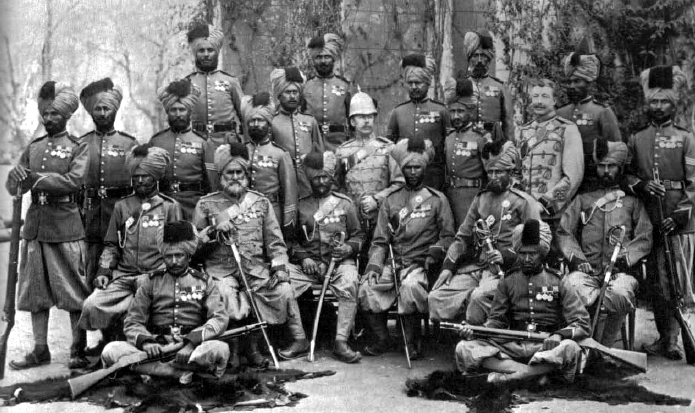
As soon as the news of the incursion of the Mohmands was received in Peshawar, a flying column was mobilised and proceeded under the command of Lieut.-Colonel J.B. Woon, 20th Punjaub Infantry, in the direction of the fort. At dawn on the 9th of August they found the tribesmen in force in a strong position near Shabdakr. The force at Colonel Woon’s disposal was small. It consisted of:—
4 Guns 51st Field Battery. 2 squadrons 13th Bengal Lancers..... 151 lances. 2 Companies Somersetshire Light Infantry.. 186 rifles. 20th Punjaub Infantry ...... 400
A total of about 750 men. The enemy numbered 6000. Nevertheless it was decided to attack at once.
As the action which followed is but remotely connected with the fortunes of the Malakand Field Force, I do not intend to describe it in detail. The infantry in advancing could only attack on a front of 600 yards. The enemy’s line, being much longer, quickly turned both flanks. The fire became severe. Numerous casualties occurred. A retirement was ordered. As is usual in Asiatic warfare, it was considerably pressed. The situation at about nine o’clock appeared critical. At this point Brigadier-General Ellis, commanding the Peshawar District, arrived on the field. He immediately ordered the two squadrons of the 13th Bengal Lancers to move well to the right flank, to charge across the front and check the enemy’s advance. The “cease fire” sounded as on a field day. Then there was a pause. The movements of the cavalry were concealed from most of the troops, but suddenly all noticed the slackening of the enemy’s fire. Then the tribesmen were seen to be in retreat and disorder. The power of cavalry had been strikingly displayed. The two squadrons, ably led, had executed a fine charge over what theorists would call impossible ground for a distance of one and a half miles along the bed of a great nullah, and among rocks and stones that reduced the pace to a trot. The enemy were driven from the field. Sixty were actually speared by the Lancers, and the rest retreated in gloom and disorder to their hills across the frontier.
The casualties were as follows:—
British Officers.
Wounded severely—Major A. Lumb, Somersetshire Light Infantry.
" " Captain S.W. Blacker, R.A.
" " 2nd Lieut. E Drummond, Somersetshire Light Infantry.
Wounded slightly—Lieut. A.V. Cheyne, 13th Bengal Lancers.
British N.C.O.'s and Soldiers.
Killed. Wounded.
51st Field Battery, R.A..... 0 2
Somersetshire Light Infantry... 3 9
Native Ranks.
13th Bengal Lancers ..... 1 12
20th Punjaub Infantry..... 5 35
Followers ....... 0 1
Total Casualties, all ranks—72.
That such an outrage, as the deliberate violation of British territory by these savages, should remain unpunished, “Forward Policy” or no “Forward Policy,” was of course impossible. Yet the vacillation and hesitancy which the Government of India had displayed in the matter of the Bunerwals, and the shocking and disgraceful desertion of the forts in the Khyber Pass, were so fresh in all men’s minds, that the order to advance against the Mohmands was received with feelings of the greatest relief throughout the forces. The general plan of the operations as arranged by the Commander-in-Chief was as follows:—
1. Sir Bindon Blood with two brigades of the Malakand Field Force and due proportions of cavalry and guns was to move through South Bajaur to Nawagai, and on the 15th of September invade the Mohmand country from that place.
2. On the same date Major-General Elles with an equal force would leave Shabkadr, and entering the mountains march northeast to effect a junction.
3. This having been done, the combined forces under the supreme command of Sir Bindon Blood would be brought back through the Mohmands’ territories to Shabkadr. Incidentally they would deal with the Hadda Mullah’s village of Jarobi, and inflict such punishment on the tribesmen as might be necessary to ensure their submission. The troops would then be available for the Tirah Expedition, which it had by this time been decided to organise.
The fact that after leaving Nawagai, nothing was known of the configuration of the country, of which no maps existed; nor of the supplies of food, forage and water available by the way, made the preparations for, and the execution of, these operations somewhat difficult. Wide margins had to be allowed in the matter of rations, and in order to be prepared for all contingencies and obstructions of ground, Sir Bindon Blood equipped his 2nd Brigade entirely with mule transport. The 3rd Brigade with camels would follow if the road was passable.
The following was the composition of the forces employed:—
I. MALAKAND FIELD FORCE.
Commanding—Major-General Sir Bindon Blood.
2nd Brigade.
Brigadier-General Jeffries, C.B.
The Buffs.
35th Sikhs.
38th Dogras.
Guides Infantry.
No.4 Company (Bengal) Sappers and Miners.
No.7 Mountain Battery.
3rd Brigade.
Brigadier-General Wodehouse.
The Queen's Regiment.[This regiment had replaced the Gordon
Highlanders in the 3rd Brigade.]
22nd Punjaub Infantry.
39th Punjaub Infantry.
No.3 Company (Bombay) Sappers and Miners.
No.1 Mountain Battery, R.A.
Cavalry—11th Bengal Lancers.
Line of Communications. 1st Brigade.
Brigadier-General Meiklejohn.
Royal West Kent.
Highland Light Infantry.
31st Punjaub Infantry.
24th Punjaub Infantry.
45th Sikhs.
No.7 British Mountain Battery.
And the following additional troops:—
1 Squadron 10th Bengal Lancers.
2 Squadrons Guides Cavalry.
II.THE MOHMAND FIELD FORCE.
1st Brigade.
1st Battalion Somersetshire Light Infantry.
Maxim Gun Detachment, 1st Battalion Devonshire Regiment.
20th Punjaub Infantry.
2nd Battalion 1st Gurkhas.
Sections A and B No.5 British Field Hospital.
Three Sections No.31 Native " "
Section A No.45 " " "
2nd Brigade.
2nd Battalion Oxfordshire Light Infantry.
9th Gurkha Rifles.
37th Dogras.
Sections C and D No.5 British Field Hospital.
No.44 Native Field Hospital.
Divisional Troops.
13th Bengal Lancers.
No.3 Mountain Battery, Royal Artillery.
No.5 (Bombay) Mountain Battery.
No.5 Company (Bengal) Sappers and Miners.
28th Bombay Pioneers.
1st Patiala Infantry.
Sections C and D No.63 Native Field Hospital.
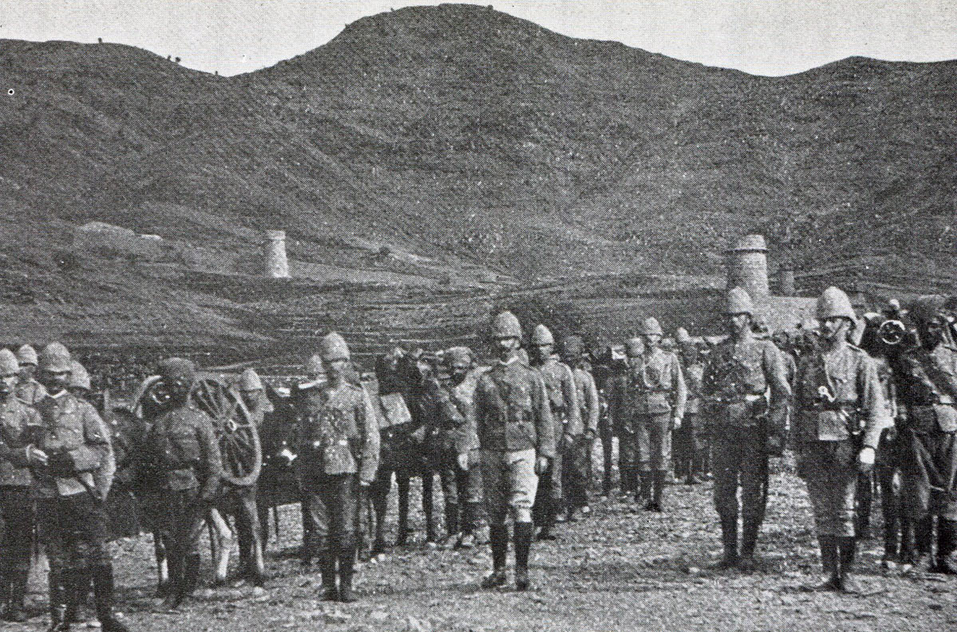
To record the actual movements of troops in a campaign, is among the most important duties of one who undertakes to tell its tale. For the sake of clearness, of brevity, and that the reader who is not interested may find convenience in skipping, I shall at once describe the whole of the marches and manoeuvres, by which Sir Bindon Blood moved his brigades across the Panjkora River, and after the Malakand Field Force is safely camped at Ghosam, the reader will be invited to return to examine the scenery, and remark the incidents of the way.
During the end of August, the 2nd Brigade, equipped with mule transport, was at Khar in the Swat Valley. The 3rd Brigade was at Uch. On the 2nd of September, definite orders to advance were received from Simla. In pursuance of these instructions, Sir Bindon Blood ordered Brigadier-General Wodehouse with the 3rd Brigade, which in anticipation had been moved from Uch a few days previously, to take over the bridge across the Panjkora from the Khan of Dir’s Levies, and secure the passage. On the 6th, the 3rd Brigade marched from Sarai to Panjkora, and obtained possession of the bridge just in time to prevent it falling into the hands of the enemy, who had already gathered to seize it. The 12-pounder guns of the 10th Field Battery were placed in a strong position commanding the passage, and the brigade camped on the left bank. On the same day, Brigadier-General Jeffries with headquarters marched from Khar to Chakdara. On the 7th he proceeded to Sarai, and on the 8th effected the passage of the Panjkora, and camped on the further bank at Kotkai. On the 10th, both brigades marched to Ghosam, where they concentrated. On the line of communications to the Malakand, stages were established at Chakdara and Sarai, with accommodation for sick and wounded. An advanced depot was formed behind the Panjkora, to guard which and to hold the passage, an additional force was moved from the Swat Valley.
This concentration at Ghosam, of which the details had worked out so mechanically, had been necessitated by the attitude of the tribesmen of Bajaur and the adjoining valleys. Great gatherings had collected, and up to the 7th of September there had been every sign of determined opposition. So formidable did the combination appear, that Sir Bindon Blood arranged to have at his disposal a force of six squadrons, nine battalions and three batteries, in the expectation of an action at or near Ghosam, which would perhaps have been on a larger scale than any British engagement since Tel-el-Kebir. [As so many misconceptions exist as to the British casualties in this victory, it is necessary to state that in the twenty minutes’ fighting 11 officers and 43 men were killed and 22 officers and 320 men were wounded.]
These anticipations were however doomed to disappointment. The methodical, remorseless advance of powerful forces filled the tribesmen with alarm. They made a half-hearted attempt to capture the Panjkora bridge, and finding themselves forestalled, fell again to discussing terms. In this scene of indecision the political officers employed all their arts. And then suddenly the whole huge combination, which had been raised in our path, collapsed as an iceberg, when southern waters have melted its base.
Whatever the philanthropist may say, it would appear to have been better policy to have encouraged the tribesmen to oppose the advance in the open, on some well-defined position. Had they done so, there can be no doubt that the two fine brigades, backed by a powerful artillery, and under a victorious commander, who knew and had fought over every inch of the ground, would have defeated them with severe loss. Bajaur would have been settled at a single blow and probably at a far less cost in lives than was afterwards incurred. Instead of this, it was the aim of our diplomacy to dissipate the opposition. The inflammation, which should have been brought to a head and then operated on, was now dispersed throughout the whole system, with what results future chapters will show.
Having thus brought the brigades peacefully to Gosham, I ask the reader to return to the Malakand and ride thence with the Headquarters Staff along the line of march. On the 5th of September, Sir Bindon Blood and his staff, which I had the pleasure to accompany, started from the Kotal Camp and proceeded across the plain of Khar to Chakdara. Here we halted for the night, and as the scenery and situation of this picturesque fort have already been described, the march may be continued without delay next morning. From Chakdara to Sarai is a stage of twelve miles. The road runs steadily up the valley until the summit of the Catgalla Pass is reached. “Catgalla” means “Cut-throat,” and, indeed, it is not hard to believe that this gloomy defile has been the scene of dark and horrid deeds. Thence a descent of two miles leads to Sarai. On the way, we fell in with the 2nd Brigade, and had to leave the road to avoid the long lines of mules and marching men who toiled along it.
The valley at Sarai is about two miles wide, and the mountains rise steeply from it. On every ridge it is possible to distinguish the red brick ruins which were the dwellings of the ancient Buddhists. These relics of an early civilisation, long since overthrown and forgotten, cannot fail to excite interest and awaken reflection. They carry the mind back to the times “when the smoke of sacrifice rose from the Pantheon, and when camelopards and tigers bounded in the Flavian amphitheatre.” And they also lead us to speculations of the future, till we wonder whether the traveller shall some day inspect, with unconcerned composure, the few scraps of stone and iron which may indicate the British occupation of India. Few, indeed, the remains would be—for we build for immediate use, not future ostentation in these days, and if we should ever cease to be a force in the world, all traces of us would soon be obliterated by time. Yet, perhaps, if that unborn critic of remote posterity would remember that “in the days of the old British,” the rice crop had been more abundant, the number of acres under cultivation greater, the population larger and the death rate lower, than at any period in the history of India—we should not be without a monument more glorious than the pyramids.
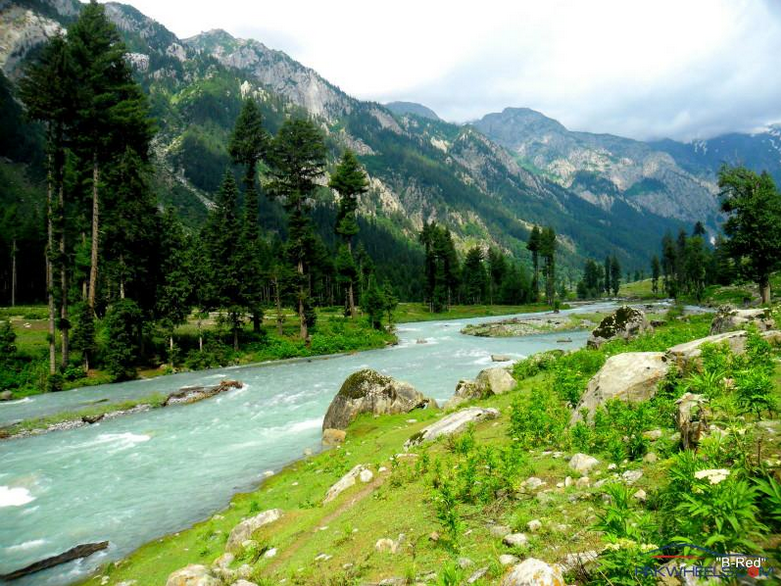
We camped with the 2nd Brigade on the night of the 6th, and next morning, while the stars were still shining, resumed the march. Five miles from Sarai the road dwindles to a mule track, and henceforward is not fit for wheeled traffic. In spite of this, the 10th Field Battery had succeeded in getting their guns along it, and had brought them safely to Panjkora. But soldiers will accomplish a good deal to get nearer the enemy. The scenery before the gorge of the river is reached is gloomy, but grand. Great cliffs tower up precipitously on the further bank and the path is cut in the face of the rock. The river, which flows swiftly by, plunges into a narrow cleft about a mile below the bridge, and disappears among the mountains. It abounds in fish, but is rapid and dangerous, and while the troops were encamped near it, two gunners lost their lives by falling in, and being carried down. Indeed, watching the dead bodies of several camels being swept along, swirled around, and buffeted against the rocks, it was not hard to understand these accidents.
At length, the bridge is reached. It is a frail structure, supported on wire ropes. At each end are gates, flanked by little mud towers. The battery was established on a knoll to the right, and the long muzzles of the guns peered through stone embrasures at the opposite hills. It was round the bases of these hills that much hard fighting took place in the Chitral campaign. About half a mile beyond the bridge, I was shown the place where the Guides had been so hard pressed, and for a whole night had had to stand at bay, their colonel killed, the bridge broken, and the river in flood, against the tribesmen in overwhelming numbers.
The field telegraph stopped at the bridge-head, and a small tent with a half-dozen military operators marked the breaking of the slender thread that connected us, across thousands of miles of sea and land, with London. Henceforward a line of signal stations with their flickering helios would be the only links. We were at the end of the wire. I have often stood at the other and watched the tape machine click off the news as it arrives; the movements of the troops; the prospects of action; the fighting; the casualties. How different are the scenes. The club on an autumn evening—its members grouped anxiously around, discussing, wondering, asserting; the noise of the traffic outside; the cigarette smoke and electric lights within. And, only an hour away along the wire, the field, with the bright sunlight shining on the swirling muddy waters; the black forbidding rocks; the white tents of the brigade a mile up the valley; the long streak of vivid green rice crop by the river; and in the foreground the brown-clad armed men. I can never doubt which is the right end to be at. It is better to be making the news than taking it; to be an actor rather than a critic.
To cross the bridge, it was necessary to dismount and lead the horses over in single file. Even then the swinging of the whole structure made it difficult to walk. The passage of the transport under such conditions occupied all the day, and the unfortunate officers in charge of the mule trains were working incessantly. The staff passed quickly, however, and riding on about a mile forded the tributary stream of the Jandol, and reached the camp at Kotkai about noon. Thence we proceeded on the following day to Ghosam, but as the road is uninteresting, and I am beginning to think the reader will readily excuse further description, we need not toil along it in the dust and the heat. The narration of the daily movements of troops, unmarked by variety of incident, is dull and wearying. Yet he who would obtain a true idea of the soldier’s life on service, must mentally share the fatigues of the march and the monotony of the camp. The fine deeds, the thrilling moments of war, are but the high lights in a picture, of which the background is routine, hard work, and discomfort.
At Ghosam the 2nd Brigade remained until joined by the 3rd and pending negotiations between the political officers and the tribal Jirgahs.
The use of purely local terms in all writing is to be deprecated. Perhaps the reason that no popular history of India exists, is to be found in the outlandish names of the characters, and the other expressions with which the pages are sprinkled. In this account I have zealously tried to avoid the ugly jargon of a degraded language, and to minimise the use of native names. The term just employed has, however, been so freely used in the newspapers recently, that it is perhaps as well to explain its meaning. A Jirgah is a deputation of tribesmen. It does not necessarily represent the tribe. It may present—and very often does—a minority report. Occasionally it expresses the opinion only of its own members. What has been settled one day is therefore very often overruled the next. The Jirgah may accept terms of peace in the morning, and the camp may be rushed that night. These were, however, genuine, and spoke in the name and with the authority of the tribes. All day they kept arriving and squatting in rows before Major Deane’s tent, to hear the Government terms. The chief condition imposed, was the surrender of rifles. A fixed number, based on calculation of wealth and population, was demanded from each clan. This method of punishment is peculiarly galling to people whose life is so full of war. No other course was, however, open but submission, and, promising that the terms should be complied with, the deputations departed. To stimulate their efforts and zeal in collecting their arms, the combined movements were delayed for three days, and the forces remained encamped at Ghosam, near Manda.
I avail myself of this halt to touch, albeit with no little trepidation, the tangled and obscure subject of tribal politics in Dir and Bajaur. All the people, incited by their priests, are bitterly hostile to the British Government, except those benefited by the subsidies paid. They were now anxious to fight, and were only restrained by a fear which fury or fanaticism might at any moment overcome. Four principal khans exercise an authority which varies locally, from absolute dominion to a shadowy suzerainty, over the whole region. The Khan of Dir, the most important, is a Government nominee. He is supported by the British influence, and is, as I have already noticed, entrusted with the raising of Levies to protect and keep in repair the Chitral road. For these services he receives pay, and a certain allowance of arms and ammunition. His own subjects are strongly opposed to his rule from dislike of his British sympathies, and he only maintains himself by the assistance which the Government gives him in arms and money. In other words he is a puppet.
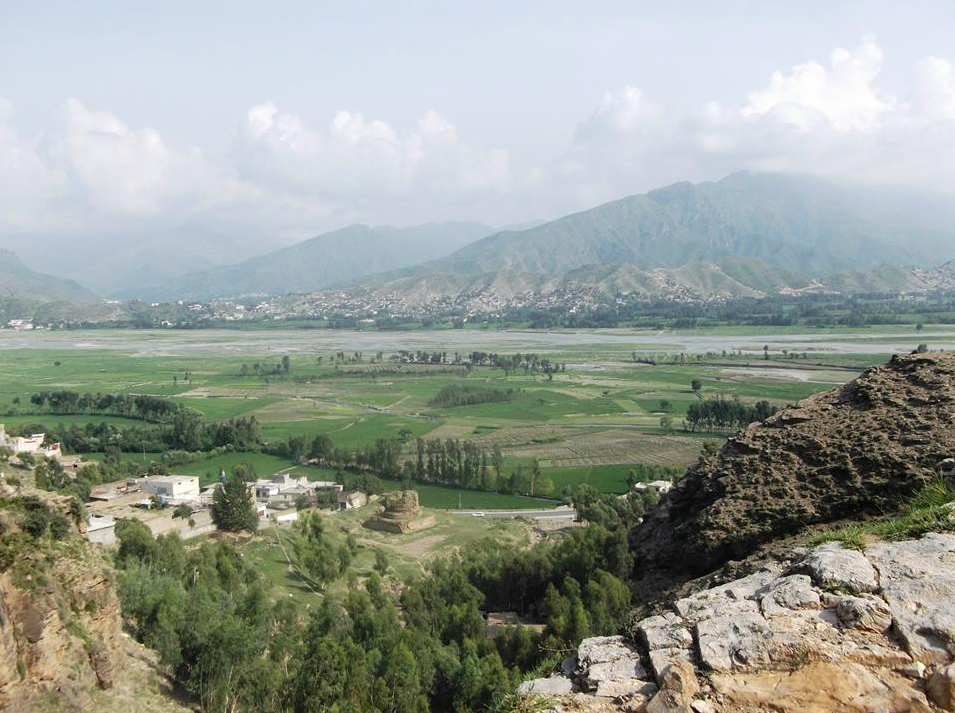
The Khan of Nawagai is constrained by fear to display a friendly attitude towards the Sirkar. His subjects resent this and his position is insecure. He receives some moral support from the British agents, and as his people are uncertain how far the Government would go to uphold him, and also as they partly realise his difficult position, they have hitherto submitted sullenly to his rule.
The position and attitude of the Khan of Jar are similar, but he is a less influential chief. The fourth potentate, the Khan of Khar, is perhaps the most honest and trustworthy. He will appear in a later chapter, and the reader will have the opportunity of judging of his character from his conduct. Thus in these valleys, while the people are all hostile, their rulers find it expedient to preserve a friendly demeanour to the British, and for this they are hated by their subjects.
At this stage, the leader of the popular party claims attention. As is usual, he is out of office. After the Chitral expedition of 1895, Umra Khan was expelled from his territories, and escaped to Cabul. There he has remained. The Amir is under an obligation to the British Government to prevent his raising trouble in Bajaur. If the Amir desired war he would send Umra Khan back. This would create a strong faction throughout the whole country—but particularly in the Jandol, Salarzai and Mamund Valleys—hostile to the British and the friendly khans. The Amir hinted at this in a recent letter to the Government of India; and such a step would probably precede his declaration of war, or follow ours. The Afghan sovereign is, however, well aware that he has at present nothing to gain, and many things to lose, by provoking a war with the great power which gave him his throne and has since increased his revenue by subsidies. In the meanwhile, anxious to preserve his influence with the border tribes, and to impress the Indian Government with the fact that he could be a powerful foe, he keeps Umra Khan as a trump card, to be played when the occasion arises. That he may maintain his authority in Bajaur, the exiled khan is well supplied with funds, with which to arm and pay his retainers.
The situation I have thus briefly described has been little altered by the operations with which future chapters are concerned. The friendly khans have been fortified in their allegiance and position by the military demonstration and by the severe punishment inflicted on those tribes who resisted. On the other hand, the hostility of the people has been not unnaturally increased by war, and one tribe in particular has gained a reputation for courage, which will give them the power to cause trouble in the future. I shall not, however, anticipate the tale.

